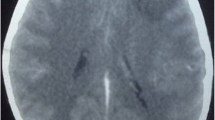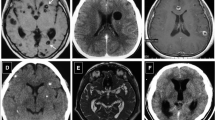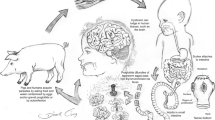Abstract.
Objective:
To evaluate the relevance of exposure and host biological factors in the heterogeneity of the clinical, radiological and inflammatory picture of neurocysticercosis (NCC).
Methods:
105 Mexican symptomatic NCC patients confirmed by imaging were studied before they received any specific treatment. The relationships studied were those between a) the patients’ characteristics (gender, age and level of exposure), b) the type of clinical picture and c) the radiological and inflammatory characteristics of the disease (number, aspect, localization of the parasites, and CSF leukocytecounts).
Results:
Results Seizures were the most frequent symptom and multiple subarachnoid cysticerci the most frequent localization. Symptomatology related to the developmental stage, number and localization of the parasites as well as the CSF leukocyte-counts. The total number of cysticercal lesions and of vesicular cysticerci increased with age,whereas the number of colloidal cysticerci decreased. CSF leukocyte-counts were higher in women than in men. Levels of exposure did not correlate with the clinical and radiological pictures.
Conclusions:
The variability found in the number, stage, localization and inflammation in the parasite lesions is strongly associated with the heterogeneity of NCC symptoms. The increased number of vesicular cysticerci and the decreased number of degenerating cysticerci with aging, as well as the prominence of inflammation in women suggest that immuno-endocrinological factors may play a role in susceptibility and pathogenesis. The data also show that with increasing age and exposure there is no increment in severity, a suggestion that there might be ways of regulating pathogenicity.
Similar content being viewed by others
References
Sciutto E, Fragoso G, Fleury A, Laclette JP, Sotelo J, Aluja A, Vargas L, Larralde C (2000) Taenia solium disease in humans and pigs: an ancient parasitosis disease rooted in developing countries and emerging as a major health problem of global dimensions. Microbes Infect 2:1875–1890
Del Brutto OH, Sotelo J, Roman GC (ed) (1998) Neurocysticercosis, a clinical handbook. Swets & Zeitlinger publishers
Thompson RCA (2001) The future impact of societal and cultural factors on parasitic disease—some emerging issues. Int J Parasitol 31:949–959
Carangelo B, Erra S, Del Basso De Caro ML, Bucciero A,Vizioli L, Panagiotopoulos K, Cerillo A (2001) Neurocysticercosis. Case Report. J Neurosurg Sci 1:43–46
Remoué F, To Van D, Schacht AM, Picquet M, Garraud O, Vercruysse J, Ly A, Capron A, Riveau G (2001) Gender-dependent specific immune response during chronic human Schistosomiasis haematobia. Clin Exp Immunol 124:62–68
Li YS, Sleigh AC, Ross AG, Li Y, Williams GM, Forsyth SJ, Tanner M, McManus DP (1999) A 2-year prospective study in China provides epidemiological evidence for resistance in humans to re-infection with Schistosoma japonicum. Ann Trop Med Parasitol 93:629–642
Baird JK (1998) Age-dependent characteristics of protection vs. susceptibility to Plasmodium falciparum. Ann Trop Med Parasitol 92:367–390
Agnew A, Fulford AJ, Mwanje MT, Gachuhi K, Gutsmann V, Krijger FW, Sturrock RF, Vennervald BJ, Ouma JH, Butterworth AE, Deelder AM (1996) Age-dependent reduction of schistosome fecundity in Schistosoma haematobium but not Schistosoma mansoni infections in humans. Am J Trop Med Hyg 55:338–343
Kabatereine NB, Vennervald BJ, Ouma JH, Kemijumbi J, Butterworth AE, Dunne DW, Fulford AJ (1999) Adult resistance to Schistosomiasis mansoni: age-dependence of reinfection remains constant in communities with diverse exposure patterns. Parasitology 118:101–105
Dessein AJ, Chevillard C, Marquet S (2000) Genetics of Parasitic Infections. Drug Metab Dispos 29:484–488
Alcais A, Abel A, David C, Torrez ME, Flandre P, Dedet JP (1997) Evidence for a major gene controlling susceptibility to tegumentary leishmaniasis in a recently exposed Bolivian population. Am J Hum Genet 61:968–979
Marquet S, Abel L,Hillaire D, Dessein H, Kalil J, Feingold J, Weissenbach J, Dessein AJ (1996) Genetic localization of locus controlling the intensity of infection by Schistosoma mansoni on chromosome 5q31-q33. Nat Genet 14:181–184
Michael E, Bundy DAP (1998) Herd immunity to filarial infection is a function of vector biting rate. Proc R Soc Lond B 265:855–860
Fleury A, Gomez T, Alvarez I, Meza D, Huerta M, Chavarria A, Carrillo Mezo RA, Lloyd C, Dessein A, Preux PM, Dumas M, Larralde C, Sciutto E, Fragoso G (2003) Silent neurocysticercosis in a rural village of Mexico: High prevalence of calcified lesions in a CT scan based epidemiological survey and its relation with exposure and host factors. Neuroepidemiology 22:139–145
Del Brutto OH, Garcia E, Talamas O, Sotelo J, Gorodezky C (1988) Sex-related severity of inflammation in parenchymal brain cysticercosis. Arch Intern Med 148:544–546
Del Brutto OH, Granados G, Talamas O, Sotelo J, Gorodezky C (1991) Genetic patterns of the HLA system: HLA A, B, C, DR, and DQ antigens in Mexican patients with parenchymal brain cysticercosis. Human Biol 63:85–93
Sotelo J, Marin C (1987) Hydrocephalus secondary to cysticercotic arachnoiditis. J Neurosurg 66:686–689
Huerta L, Terrazas LI, Sciutto E, Larralde C (1992) Immunologic mediation of gonadal effects on experimental murine cysticercosis caused by Taenia crassiceps. J Parasitol 78:471–476
Terrazas LI, Bojalil R, Govezensky T, Larralde C (1994) A role for 17-betaestradiol in immunoendocrine regulation of murine cysticercosis (Taenia crassiceps). J Parasitol 80:563–568
Larralde C, Morales J, Terrazas I, Govezensky T, Romano MC (1995) Sex hormone changes induced by the parasite lead to feminisation of the male host in murine Taenia crassiceps cysticercosis. J Steroid Biochem Mol Biol 52:575–580
Morales J, Velasco T, Tovar V, Fragoso G, Fleury A, Beltran C, Villalobos N, Aluja A, Rodarte LF, Sciutto E, Larralde C (2002) Taenia solium cysticercosis of rural pigs in Mexico: castration and pregnancy significantly increase prevalence. Vet Parasitol 108:41–48
Stamos JK, Rowley AH, Hahn YS, Chadwick EG, Schantz PM,W ilson M (1996) Neurocysticercosis: Report of unusual pediatric cases. Pediatrics 98:974–977
Butterworth AE, Curry AJ, Dunne DW, Fulford AJ, Kimani G, Kariuki HC, Klumpp R, Koech D, Mbugua G, Ouma JH (1994) Immunity and morbidity in human schistosomiasis mansoni. Trop Geogr Med 46:197–208
Rocha MO, Pedroso ER, Greco DB, Lambertucci JR, Katz N, Rocha RL, Rocha RS, Rezende DF, Neves J (1996) Pathogenetic factors of acute schistosomiasis mansoni: correlation of worm burden, IgE, blood eosinophilia and intensity of clinical manifestations. Trop Med Int Health 1:213–220
Vega R, Pinero D, Ramanankandrasana B, Dumas M, Bouteille B, Fleury A, Sciutto E, Larralde C, Fragoso G (2003) Population genetic structure of Taenia solium from Madagascar and Mexico: implications for clinical profile diversity and immunological technology. Int J Parasitol 33:1479–1485
De Aluja AS, Villalobos ANM, Plancarte A, Rodarte LF, Hernandez M, Zamora C, Sciutto E (1999) Taenia solium cisticercosis: immunity in pigs induced by primary infection. Vet Parasitol 81:129–135
Cabrera PA, Haran G, Benavidez U, Valledor S, Perera G, Lloyd S, Gemmell MA, Baraibar M, Morana A, Maissonave J (1995) Transmission dynamics of Echinococcus granulosus, Taenia hydatigena and Taenia ovis in sheep in Uruguay. Int J Parasitol 25:807–813
Huerta M, S de Aluja A, Fragoso G, Toledo A, Villalobos N, Hernandez M, Gevorkian G, Acero G, Diaz A, Alvarez I,Avila R, Beltran C, Garcia G,Martinez JJ, Larralde C, Sciutto E (2000) Synthetic peptide vaccine against Taenia solium pig cysticercosis: successful vaccination in a controlled field trial in rural Mexico. Vaccine 20:262–266
Author information
Authors and Affiliations
Corresponding author
Rights and permissions
About this article
Cite this article
Fleury, A., Dessein, A., Preux, P.M. et al. Symptomatic human neurocysticercosis. J Neurol 251, 830–837 (2004). https://doi.org/10.1007/s00415-004-0437-9
Received:
Revised:
Accepted:
Issue Date:
DOI: https://doi.org/10.1007/s00415-004-0437-9




